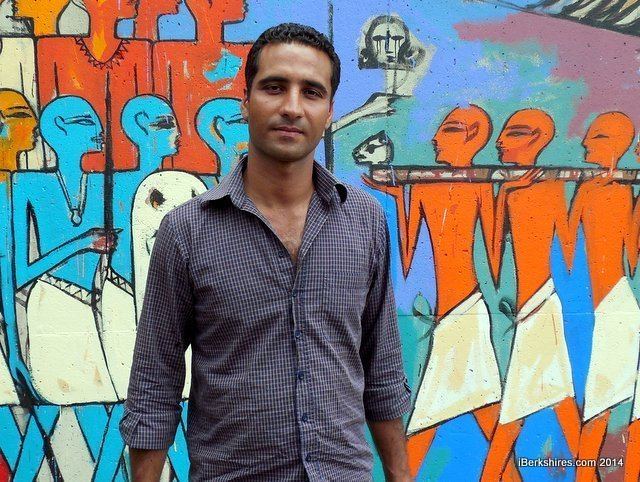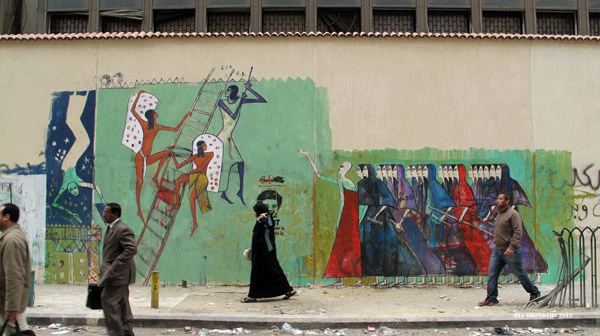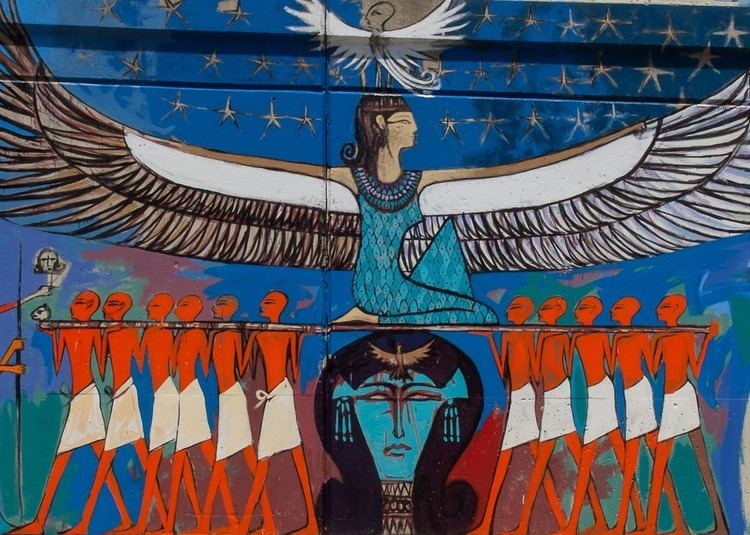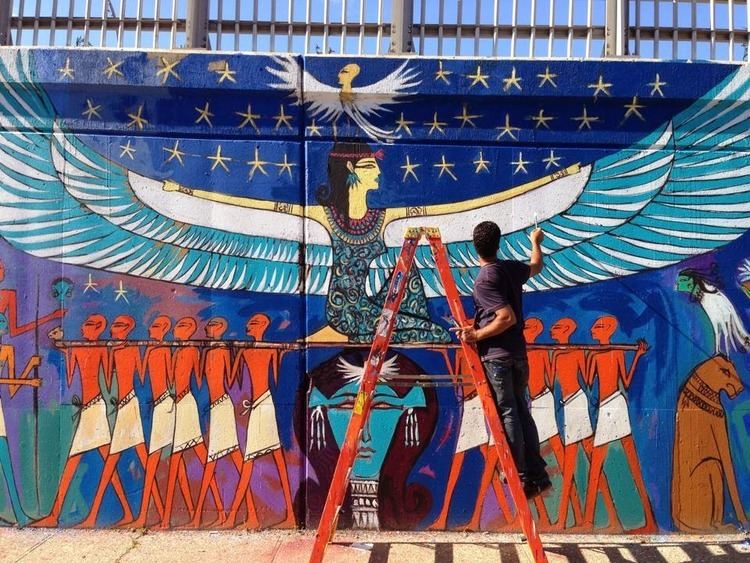Name Alaa Awad | Role Graffiti artist | |
 | ||
Education Faculty of Fine Arts in Luxor Known for GraffitiStreet artSatireSocial commentary | ||
full hd alaa awad mural justice for 2014 downstreet art in north adams ma
Alaa Awad is an Egyptian-based graffiti artist, and painter.
Contents
- full hd alaa awad mural justice for 2014 downstreet art in north adams ma
- Graffiti By Alaa Awad
- Career
- Style
- Political and social themes
- Marching Women
- Women Climbing the Ladder
- Hostesses
- References

Alaa Awad is an Egyptian graffiti artist known for his graffiti in Cairo and Luxor. He is best known for his mural paintings created on Mohamed Mahmoud Street in Cairo. His graffiti became well known after he arrived in Cairo in early 2012 following the Port Said Massacre. His graffiti then expanded to encompass the attitudes of protest against the Supreme Council of the Armed Forces (SCAF).

Graffiti By Alaa Awad
Career

Alaa Awad studied at the South Valley University Faculty of Fine Arts in Luxor and graduated in 2004. Since then he has served as a member of the faculty at the Faculty of Fine Arts as a professor in the Department of Mural Painting. His graffiti became well known in late 2011 and early 2012 after he took a break from teaching and went to Cairo following Port Said massacre to paint a memorial mural. What was meant to only be a short period of time in Cairo became a much longer and art filled time for Awad as he continued to paint new murals on Mohamed Mahmoud Street in Cairo.
Style

Unlike other graffiti artists, Awad chooses to paint with a brush and uses acrylic paints rather than using stencils and spray paints. His intricate paintings can sometimes take up to a week to make not only because of the materials he uses, but because of the complexity of his designs. Awad paints in a neo-pharonic graffiti style, a style that harkens back to Ancient Egypt. His usage of the neo-pharonic style is meant to draw attention back to rich, old Egyptian traditions. This style aims to remind protestors of their heritage and past to help them stay true to their Egyptian identity. His murals are typically multifaceted and multi-layered with each telling a different story.
Beyond the aforementioned unique style of painting, using a neo-pharonic style aims to return the prominence of graffiti in Egypt. Graffiti has played a significant role in Egyptian villages in the past, when each village had their own graffiti artist. These graffiti artists would essentially be storytellers of the village and would depict important events or celebrations through traditional imagery and symbolism. Many of these same images can be seen in Awad's artwork today as he bases his works off of famous works of art from Ancient Egypt that may be seen in temples and museums.
Political and social themes

Awad’s murals were created in Cairo following the Egyptian protests against SCAF and were painted on the walls built to keep protestors away from government buildings. In total, eight walls and seven roadblocks were constructed to keep protestors from Tahrir Square away from the Ministry of the Interior, Ministry of Justice, and Parliament House. One of the primary reasons for Awad's artwork is to demonstrate to SCAF and other ruling powers that the protestors and revolutionaries are a force to be reckoned with. The paintings along Mohamed Mahmoud Street reflect the juxtaposition between the ruling power and how their style of leadership has fueled the resistance. A major difference between Awad's graffiti and the other graffiti along the street is that Awad's graffiti is much more subtle because of the neo-pharonic style of his works. While his works will oftentimes directly tie to a social issue, such as gas tank shortages or women's rights, an underlying theme is that Egyptians as a whole must remember their past culture and history stating that "we can't know our future if we forget our past." Awad himself has indicated his own political beliefs stating that "I don't see any change in Egypt's politics, inside or out. I just see that the Muslim Brotherhood has captured the government. They want to change everything according to their own style, to make everything Muslim Brotherhood. They forget to improve things for the public. They have forgotten the people." It is for this reason that Awad took to the streets to paint his images. While his graffiti may be more complex than the pieces surrounding it, the people can identify with his artwork and is doing what the governing forces could not achieve: giving the people what they want and need.
Marching Women

"Marching Women" is a mural which consists of two main components, "women in the funeral march" and "women climb the ladder" . This work is based on an original image in the Ramesseum temple in West Bank of Luxor, a photo of engraved battle scenes on the Ramesseum's First Pylon, Thebes. The Ramesseum has some of the Egyptian world's oldest surviving pylons. A pylon, or monumental portal to an ancient Egyptian temple, usually consists of two massive upward tapering walls flanking and perpendicular to the temples entrance. Alaa Awad changed it, his painting made women instead of men apparent to the viewer. This work shows the strong role that women played in society in the past of Egypt and today. And we can see his meaning in the women's hands—they have papyrus in their hands, this communicates the meaning of knowledge .
Women Climbing the Ladder
This work, "Women Climbing the Ladder" was based on a scene located at the Ramesseum Temple in Luxor. By placing this ancient image in a more modern context it demonstrates how instrumental women were in the past and also in the present. Awad painted this piece to represent the role of women and stated the influence of the battle of Kadesh in which it is located. In this court are well preserved scenes from the battle of Kadesh. Ramesses II dashes into battle (lower row). He is depicted larger than his men, and the enemy, mostly dead and wounded, lie in heaps on the ground. The fortress of Kadesh, surrounded by a moat, divides a group of the enemy from the battlefield. These men, far from preparing themselves for battle, are lending a hand to their drowning companions. Though this mural has been considered by some as a pretentious interpretation, there is no doubt that the complexity of the composition shows development and sophistication. The individual figures, however, indicate marked deterioration from the expressive detail of the murals of Seti I's mortuary temple. Egypt has a long long history and its own traditions. This again highlights Awad bringing social issues into the limelight while also reinforcing that Egypt must return to its roots in order to move ahead.
Hostesses
On Mohamed Mahmud street is an extensive image of mural paintings inspire by ancient Egyptian painted by Alaa Awad in 2012 ."The myth of human destruction in ancient egyptian." written hieroglyphic by Amir Fouad. In fact, however, history as cultural and social memory could not be more alive in the Egyptian Revolution and its aftermath. The Revolution has reinvigorated history on the street in a way that has the capacity to produce change in society. The most tangible evidence of this is in the street murals of Mohammad Mahmoud Street, which incorporate Egyptian art in a way that endows both ancient and modern history with positive meanings. This image was expanded upon by Awad by painting a series of hostesses, or "ladies-in-waiting," which was meant to "portray a centuries" old feminine wisdom with a welcoming smile. This image shows the kindness of the hostess, representing the people, juxtaposed. The position of this figures inspire by the position of the figures unfinished in Tomb of Ramose.
